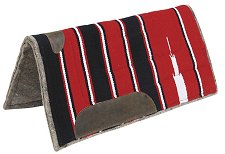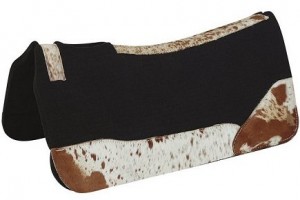
A saddle pad is used to protect a horse’s back during riding. It is usually thicker than a “saddle blanket” and often made of layers of wool, felt, sheepskin, or synthetic materials including gels. A saddle pad is designed to absorb shock, eliminate pressure points, and minimize your horse’s back fatigue. Equally as important, it should also remove sweat moisture and cool the horse’s back.
In western riding, the pad is usually rectangular and shows around the saddle.
While it is not a substitute for a well-fitted saddle, a saddle pad can sometimes compensate for small fit differences such as the difference between a horse’s weight in winter and summer. Some have shims for more customs fit.
Some have cut-outs where the withers of the horse protrude. The withers opening makes it easier to fit a pad to different horses with varying withers heights.
Some even have cut-outs down the middle to get added heat dissipation.
Most have leather protection pads under the saddle gullet and on the sides near the stirrup leather to protect against excessive wear in those areas.
A saddle pad is said to be a “close contact”pad if it does not have bulk under the stirrup leathers or under the legs of the rider, thus offering “close contact” with the horse. This is particularly important for performance horses that take cues from a rider’s leg position and pressure.
Close contact is achieved by either “cutting out” a portion of the pad skirt under the rider’s legs or by thinning the material in that area by some other means.
Square saddle pads do not fit a horse’s back. Getting the pad to conform to the horses’s anatomy takes “break-in” and still never really gives adequate protection against pressure points. Most over-cinching is caused by a poor fit of the saddle pad for which many people compensate by adding a second pad. The pre-formed Contoured Saddle Pad already fits the contour of your horse’s back. It takes practically no break-in, and it helps eliminate slippage without over-cinching.
The Type of the Pad for the Type of Activity: The type and size of pad your horse needs is sometimes dictated by the activity your horse will perform. Cutting horses are usually used for shorter bursts of time and need agility, so often use a thinner pad than roping horses who must absorb large concussions and shock during their work. Endurance riding demands a light pad that distributes weight over long rides but dissipates heat and moisture. And pleasure riders need a pad that will work in many varied conditions.
Extended riding requires a pad that does not extend beyond the saddle skirt by more than an inch or two all of the way around. More pad skirting means more trapped heat. More pad skirting keeps the rider’s legs away from the horse, inhibiting contact. More pad skirting can interfere with the horse’s agility. Barrel horses need less skirting and/or rounded corners for tighter turns (see picture above).
Saddle Pad Materials: Natural and Synthetic
Wool: Nothing beats it after all of these years. Besides being a 100% natural material, wool has many attributes that make it the best material for saddle pads. Wool has a unique ability to deal with perspiration. The outer layer of each shaft repels water, while the inner core absorbs water. It is a little like a disposable baby diaper. Moisture goes in and stays in – away from the skin. Wool can absorb and wick up to 3 times its weight in water. It is amazing at wicking the sweat off your horse’s back and distributing it throughout the pad and away from the skin.
Additionally, a 1″ thick piece of compressed wool (felt) is extremely efficient at reducing pressure point damage, which is caused by a combination of heat build-up, friction, and pressure. Wool helps dissipate the heat by locking it between the fibers in millions of tiny air pockets formed by the fibers interlocking structure. Wool’s ability to stretch and compress (known as “crimp”) makes it a superior compression protector to help prevent both pressure and friction. Wool has higher compression strength and can “bounce back” better than other materials.
(Mohair shares many of the same characteristics as Wool but is softer and usually costs more.)
Humans have long known that wool socks provide the best protection against blisters and the best perspiration-wicking ability. The “saddle is to the pad” what the “shoe is to sock”.
Foam Both open and closed cell foam are used in saddle pads today. Neither offers good moisture protection, and they do not “breathe” at all, so heat builds up dangerously.
Neoprene: Neoprene is a very spongy, rubber-like material. The flexible rubber has been infused with nitrogen gas bubbles. It is soft and comfortable against the skin and has good insulating properties. It adds reinforcement if used around a flexible object (such as pastern bandages) and provides cushion and shock absorption when used under objects (such as saddle pads). However, when neoprene gets wet from sweat against a horse’s skin it can slip, causing friction injury. Neoprene saddle pads can also increase the heat build-up under a saddle and may contribute to heat pressure galling and damage.
Synthetic Fleece is usually used on inexpensive saddle pads to offer bright colors and velvety touch. Most synthetics will absorb neither moisture nor heat. Anyone who has lived in the Southern US in the summer knows that cotton clothing is the best material for heat and sweat dissipation, and polyester clothing gets hot while sweat runs off of you. If you wouldn’t wear it, don’ t put it on your horse no matter how pretty.
Synthetic Hospital Orthopedic Felt and Military-grade Flack-jacket memory foam. Both of these synthetic materials have recently been used in saddle pads. Memory foam (and other types of foams) lose their compression strength over time, bottoming out after prolonged use. Most synthetics in general are poor at best. Nearly all others hold or build heat. Heat causes moisture, and rubbing against moist skin and hair causes sores.
Shop All Saddle Pads
We certainly don’ t know everything. Please share your expertise an d experiences. Comment on what is already written or Suggest a Category and Educate us about it. Grow Horse-Pros.com©

